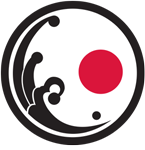Asian Arts Council 2014-2015 General Meeting Lectures
Each month the Asian Arts Council presents a program featuring a distinguished scholar, curator, collector or Asian arts enthusiast of note. We meet the last Thursday of the month in the Museum’s Boardroom at 1:00 p.m. and begin with a brief business meeting before the lecture. Meetings are free for AAC members, only $10 for Museum members, $12 for non-members and $8 for students.
Return to Archives
Jul. 31 - 1:00 p.m. Addiction: The Psychology of Collecting Clare Chu, CEO of the Asian Arts Studio, Inc
AAC Newsletter – August 2014, p 2 Lecture Flyer
In her presentation, Addiction: The Psychology of Collecting, Clare Chu, CEO of the Asian Arts Studio, provided revealing insights into the traits and motives of collectors.
The Qianlong emperor (1711-1799) of the Qing dynasty was an avid collector who amassed thousands of objects, inscribing his own poems on many of them. The elite Chinese literati collected for their own enjoyment of the beauty or uniqueness of an object as well as to share their connoisseurship and elevate their own prestige within their circle of friends.

Motivations of collectors can include: the desire to display the objects, or social contact with other collectors; the gaining of knowledge about the objects and their history, or as an investment; the inspiration of the spiritual or sacred nature of the objects. The personal traits of collectors range from a quest for excellence in their chosen objects to an almost obsessive desire to acquire just one more exquisite or rare or extravagant example for their collection. Avery Brundage was quoted as saying: “Collecting is not a hobby, but an addiction.”
Aug. 28 - 1:00 p.m. The Asian Art Market: Art Collecting and the Public Interest Kate Fitz Gibbon, Santa Fe Attorney
AAC Newsletter – September 2014, p 2 Lecture Flyer
Kate Fitz Gibbon, Santa Fe-based attorney,  outlined the many complications created by conflicting laws regarding cultural property and provenance of art objects that are collected, purchased abroad or donated to museums, including objects long held in museum collections. There are groups that actively campaign against art collecting and museum’s collections and promote the repatriation of most objects back to their country of origin. She cited the recent example of several 10th century Khmer statues from Koh Ker, north of the nearby Angkor Wat complex, that were returned by the Metropolitan Museum of Art, the Norton Simon Museum and Sotheby’s after the Cambodian government applied pressure.
outlined the many complications created by conflicting laws regarding cultural property and provenance of art objects that are collected, purchased abroad or donated to museums, including objects long held in museum collections. There are groups that actively campaign against art collecting and museum’s collections and promote the repatriation of most objects back to their country of origin. She cited the recent example of several 10th century Khmer statues from Koh Ker, north of the nearby Angkor Wat complex, that were returned by the Metropolitan Museum of Art, the Norton Simon Museum and Sotheby’s after the Cambodian government applied pressure.
Sep. 25 - 1:00 p.m. Pictorial Narratives in Japanese Painting Xiaojin Wu, Ph.D., Curator of Japanese and Korean Art The Seattle Asian Art Museum
AAC Newsletter – October 2014, p 2 Lecture Flyer
Xiaojin Wu, Ph.D., Associate Curator of Japanese and Korean Art at the Seattle Asian Art Museum, presented Pictorial Narratives in Japanese Painting.  From her museum’s extensive collection, she showed how the 16th century handscroll, Legend of Hasedera Temple, allowed the viewer to journey through time and space as it was unfurled. Although some handscrolls were subsequently cut into segments and mounted as hanging scrolls, the narrative could still me recreated in the imagination if it was a familiar and well known story. Folding screens often told a story in many episodes as separate vignettes divided by cloud forms. A particularly interesting screen of black crows on a gold background had no story to tell, but created a slightly menacing psychological mood reminiscent of Hitchcock’s film, The Birds.
From her museum’s extensive collection, she showed how the 16th century handscroll, Legend of Hasedera Temple, allowed the viewer to journey through time and space as it was unfurled. Although some handscrolls were subsequently cut into segments and mounted as hanging scrolls, the narrative could still me recreated in the imagination if it was a familiar and well known story. Folding screens often told a story in many episodes as separate vignettes divided by cloud forms. A particularly interesting screen of black crows on a gold background had no story to tell, but created a slightly menacing psychological mood reminiscent of Hitchcock’s film, The Birds.
Oct. 30 - 1:00 p.m. The Mysteries of Sanxingdui: an Ancient Chinese Archaeological Site that Startled the World Suzanne Cahill, Ph.D., Adjunct Professor, Department of History, UCSD
AAC Newsletter – November 2014, p 2 Lecture Flyer
Dr. Suzanne Cahill presented a tantalizing preview of the exhibit at the Bowers Museum, China’s Lost Civilization: The Mystery of Sanxingdui, that we will be visiting on our January 15 bus trip. In 1986, Chinese archaeologists working at Sanxingdui (Three Star Mound) 三星堆 in Sichuan province in southwest China made a dramatic discovery that startled the world and threw the received narrative of Chinese history into great confusion. The artifacts found were unlike those of any other ancient Chinese culture, causing a reassessment of Chinese history that up until that time had placed the cradle of Chinese civilization 750 miles to the northeast in the Yellow River Plain region. The two large pits that were excavated contained layers of many different objects, including monumental bronze figures of humans and imaginary creatures, jade ritual pieces, and numerous elephant tusks, all dating from 1250 - 1100 BCE. Three large masks are in the form of human heads with supernatural features including large wing-like ears and monstrously protruding eyes. The Sanxingdui culture left no written record or human remains and appears to have existed for only about 350 years before it vanished.
The artifacts found were unlike those of any other ancient Chinese culture, causing a reassessment of Chinese history that up until that time had placed the cradle of Chinese civilization 750 miles to the northeast in the Yellow River Plain region. The two large pits that were excavated contained layers of many different objects, including monumental bronze figures of humans and imaginary creatures, jade ritual pieces, and numerous elephant tusks, all dating from 1250 - 1100 BCE. Three large masks are in the form of human heads with supernatural features including large wing-like ears and monstrously protruding eyes. The Sanxingdui culture left no written record or human remains and appears to have existed for only about 350 years before it vanished.
Adding to the mystery of a highly developed culture that had sophisticated bronze-casting skills, the contents of the pits appear to have been deliberately, probably ritually, burned and broken.  Prior to these discoveries, historians thought that only the simplest Neolithic settlements existed at this time in Sichuan. The exhibition at the Bowers Museum displays important pieces from this find, many of which have never been seen in the U.S. before. The exhibition also displays materials excavated in 2001 at Jinsha, a nearby, slightly later, and probably related site. The objects pose fundamental questions about the people who made them, their relation to other cultures of the same period, the meaning of the objects buried in the pits, the source of the elephant tusks, and most of all, their relation to the people of modern China.
Prior to these discoveries, historians thought that only the simplest Neolithic settlements existed at this time in Sichuan. The exhibition at the Bowers Museum displays important pieces from this find, many of which have never been seen in the U.S. before. The exhibition also displays materials excavated in 2001 at Jinsha, a nearby, slightly later, and probably related site. The objects pose fundamental questions about the people who made them, their relation to other cultures of the same period, the meaning of the objects buried in the pits, the source of the elephant tusks, and most of all, their relation to the people of modern China.
Dec. 02 - 11:00 a.m. Heritage Luncheon & Silent Auction Stephen Little, Ph.D., Curator and Head of the Chinese and Korean Art Department, LACMA
AAC Newsletter – January 2015, p 1 Luncheon Invitation
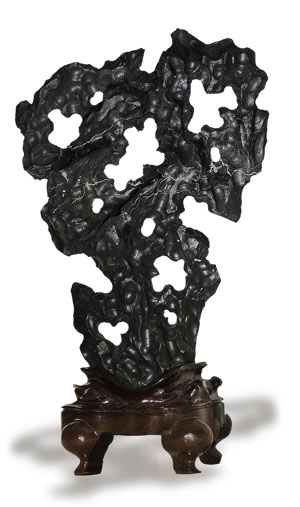 Dr. Stephen Little, curator of Chinese and Korean art at LACMA was the speaker for the luncheon. His topic was Stones in Chinese Culture and Art, and it was a very interesting and entertaining talk.
Dr. Stephen Little, curator of Chinese and Korean art at LACMA was the speaker for the luncheon. His topic was Stones in Chinese Culture and Art, and it was a very interesting and entertaining talk.
Jan. 29 - 1:00 p.m. Japanese Design: Aesthetic Components, Cultural Sources, Worldwide Promoters Patricia J. Graham, Ph.D., Certified appraiser
AAC Newsletter – February 2015, p 2 Lecture Flyer
In January, Dr. Patricia Graham’s lecture on Japanese Design: Aesthetic Components, Cultural Sources, Worldwide Promoters highlighted the unique qualities inherent in Japanese design traditions that can be traced to the Japanese culture itself and the influence of beliefs in Shinto and Buddhism. A deep appreciation for the natural world inspires the design elements of wabi sabi, representing a rustic simplicity whose imperfections are embraced. 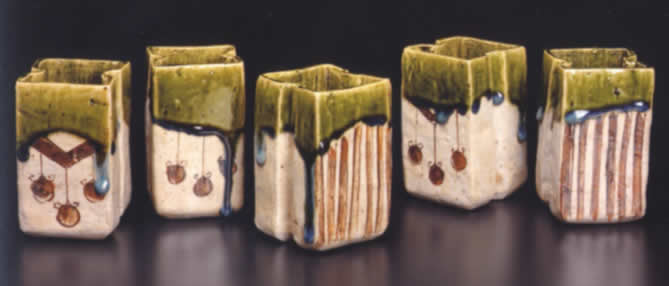 ther important design elements are line, color, texture, asymmetrical balance and nōtan, the principle of contrasting light and dark or negative and positive space. Another intriguing concept is ma, the influence of empty space or the space between articulated elements that contributes to the overall perception of a design. She also focused on several writers who introduced Japanese design to the West during the late 19th century and early 20th century such as Ernest Fenollosa, an American scholar influential in both Japan and America who promoted appreciation of Japanese art. He helped to establish the Tokyo Imperial Museum and the Oriental Art department of the Museum of Fine Arts in Boston, and selected the Japanese art to be displayed at the 1893 World Columbian Exposition in Chicago. Josiah Conder was a British architect who, while teaching Western techniques of architecture in Tokyo, developed a keen interest in Japanese art, and published books on Japanese painting and flower arrangement and one on landscape gardening in Japan that influenced the early Japanese-style gardens in the U.S.
ther important design elements are line, color, texture, asymmetrical balance and nōtan, the principle of contrasting light and dark or negative and positive space. Another intriguing concept is ma, the influence of empty space or the space between articulated elements that contributes to the overall perception of a design. She also focused on several writers who introduced Japanese design to the West during the late 19th century and early 20th century such as Ernest Fenollosa, an American scholar influential in both Japan and America who promoted appreciation of Japanese art. He helped to establish the Tokyo Imperial Museum and the Oriental Art department of the Museum of Fine Arts in Boston, and selected the Japanese art to be displayed at the 1893 World Columbian Exposition in Chicago. Josiah Conder was a British architect who, while teaching Western techniques of architecture in Tokyo, developed a keen interest in Japanese art, and published books on Japanese painting and flower arrangement and one on landscape gardening in Japan that influenced the early Japanese-style gardens in the U.S.
Feb. 26 - 1:00 p.m. Art from the Land of Diamonds: India's Deccan Courts Marika Sardar, Ph.D., Associate Curator of
Southern Asian and Islamic Arts
AAC Newsletter – March 2015, p 2 Lecture Flyer
Marika Sardar, Ph.D., our Associate Curator of Southern Asian and Islamic Art transported us to India with her presentation of Sultans of Deccan India, 1500-1700: Opulence and Fantasy. Five great sultanates ruled over the Deccan plateau in central India at the same time as the Mughal Empire in northern India, producing exceptional paintings, textiles and metalwork. 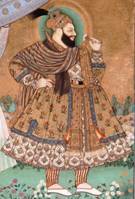 This diamond-rich region attracted artists, poets, writers, and traders from all over the world, including Iran, Turkey, Africa, and Europe. At its zenith, the Deccan became home to Indian and Persian artists, the abode of African elites, and the place where European discoverers embraced new tastes in textiles and gems. Although at the end of the 17th century, the Deccan courts gave way to Mughal domination from the north, their preceding efflorescence brought the arts of painting to new heights.
This diamond-rich region attracted artists, poets, writers, and traders from all over the world, including Iran, Turkey, Africa, and Europe. At its zenith, the Deccan became home to Indian and Persian artists, the abode of African elites, and the place where European discoverers embraced new tastes in textiles and gems. Although at the end of the 17th century, the Deccan courts gave way to Mughal domination from the north, their preceding efflorescence brought the arts of painting to new heights.
[ Portrait of Sultan Abu'l Hasan of Golconda, Standing SDMA 1990.491]
Marika’s talk drew from her extensive research and trips to India to co-curate the exhibition, Sultans of Deccan India, 1500-1700: Opulence and Fantasy, opening at the Metropolitan Museum of Art in April. It will be the most comprehensive museum presentation on the Deccan sultanates to date, and will bring together some 200 of the finest works from major international, private, and royal collections, including paintings from our Edwin Binney 3rd Collection.
A trip to attend the opening is being planned by the Committee for the Arts of the Indian Subcontinent, April 11-15, 2015. Space is limited and reservations must be made by Monday, March 9.
Saturday, Mar. 28 - Copely Auditorium The Quintessence of Chinese Traditional Ink Painting: Commune with nature through the heart and soul Wu Yi, Chinese Master Painter
AAC Newsletter – April 2015, p 2 Lecture Flyer
 A very interesting program by the Chinese master painter Wu Yi included the pleasure of viewing a display of six of his original works, a short video biography and numerous slides illustrating the wide range of his subject matter. With the able translation of Ping-Hui Ku (who has studied with him for many years), he spoke of the deep-seated influence on his work of the Chinese concept of “Xiang Thought” that traces back to ancient times before the development of writing when images were used to record observations and events. The thoughts that were expressed in images evolved into the earliest Chinese characters that incorporated these images into a system of writing.
A very interesting program by the Chinese master painter Wu Yi included the pleasure of viewing a display of six of his original works, a short video biography and numerous slides illustrating the wide range of his subject matter. With the able translation of Ping-Hui Ku (who has studied with him for many years), he spoke of the deep-seated influence on his work of the Chinese concept of “Xiang Thought” that traces back to ancient times before the development of writing when images were used to record observations and events. The thoughts that were expressed in images evolved into the earliest Chinese characters that incorporated these images into a system of writing. 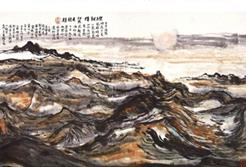 As Chinese ink paintings developed along with calligraphy, the Xiang Thought processes were embedded within the ink paintings, encompassing the long history of Chinese culture and philosophy and a reverence for nature. Wu Yi explained that these elements nourished his understanding of the natural world and allowed him to express the Three Perfections of poetry, calligraphy and painting through his own spirit using brush and ink and paper.
[Wu Yi, Greeting the Rays of the Dawn, 1984]
As Chinese ink paintings developed along with calligraphy, the Xiang Thought processes were embedded within the ink paintings, encompassing the long history of Chinese culture and philosophy and a reverence for nature. Wu Yi explained that these elements nourished his understanding of the natural world and allowed him to express the Three Perfections of poetry, calligraphy and painting through his own spirit using brush and ink and paper.
[Wu Yi, Greeting the Rays of the Dawn, 1984]
Apr. 30 - 1:00 p.m. Chinese Paintings at the San Diego Museum of Art Stephen Little, Ph.D., Curator and Head of the Chinese and Korean Art Department, LACMA
AAC Newsletter – May 2015, p 2 Lecture Flyer
To a rapt audience, Dr. Stephen Little, Curator of Chinese and Korean Art at LACMA, presented the results of his examination of the Chinese paintings in our Museum’s collection.  He stated that we have an “exciting collection,” and that the extremely long (90 feet) handscroll, The Ordination of Empress Zhang (1961.94, on display), dated 1493 is very rare and possibly one of a kind. One of the oldest paintings, Bamboo and Rock (1964.71.2), a hanging scroll dated 1301, has the imprinted seal of the Qianlong emperor (r. 1735-1796), indicating that it was a part of his imperial collection. A group of 12 high-quality fan paintings (1968.73.a-l), some dating to the 1540s, are rendered in ink on gold-flecked paper. The 17th century hanging scroll, Reflection of the Moon in the Lake of Santan (1939.4.1) was painted by Yu Ling who was the teacher of the first Qing emperor. Dr. Little considered the album of 12 paintings (1970.4.1-10) on silk dated 1755 by Huang Shen a masterpiece of our collection, and he concluded by saying that The Museum’s collection of Chinese paintings is better than LACMA’s! Dr. Little’s study of our Chinese paintings was initiated by and underwritten by the Asian Arts Council.
He stated that we have an “exciting collection,” and that the extremely long (90 feet) handscroll, The Ordination of Empress Zhang (1961.94, on display), dated 1493 is very rare and possibly one of a kind. One of the oldest paintings, Bamboo and Rock (1964.71.2), a hanging scroll dated 1301, has the imprinted seal of the Qianlong emperor (r. 1735-1796), indicating that it was a part of his imperial collection. A group of 12 high-quality fan paintings (1968.73.a-l), some dating to the 1540s, are rendered in ink on gold-flecked paper. The 17th century hanging scroll, Reflection of the Moon in the Lake of Santan (1939.4.1) was painted by Yu Ling who was the teacher of the first Qing emperor. Dr. Little considered the album of 12 paintings (1970.4.1-10) on silk dated 1755 by Huang Shen a masterpiece of our collection, and he concluded by saying that The Museum’s collection of Chinese paintings is better than LACMA’s! Dr. Little’s study of our Chinese paintings was initiated by and underwritten by the Asian Arts Council.
May 28 - 1:00 p.m. The History of the Silk Road Jim Richter, Docent
AAC Newsletter – June 2015, p 2-3 Lecture Flyer
 Jim Richter spoke on the multifaceted connections of far-flung empires in The History of the Silk Road. The term “Silk Road” is shorthand for a collection of trading routes that linked East Asia, Central Asia, India, the Middle East, and Europe. Both goods and ideas traveled along these trade routes, beginning at least 5,000 years ago. The historic period of the Silk Roads lasted for about 1,900 years, beginning about 300 BCE and ending about 1600 CE. The geography of the Silk Road includes inhospitable deserts, difficult mountain passes, steppe grasslands, and a frequently changing climate. Also, the cultures along these trading routes were often changing. Different groups of people would move into an area, introducing new political structures, new religious beliefs, and new cultural practices.
Jim Richter spoke on the multifaceted connections of far-flung empires in The History of the Silk Road. The term “Silk Road” is shorthand for a collection of trading routes that linked East Asia, Central Asia, India, the Middle East, and Europe. Both goods and ideas traveled along these trade routes, beginning at least 5,000 years ago. The historic period of the Silk Roads lasted for about 1,900 years, beginning about 300 BCE and ending about 1600 CE. The geography of the Silk Road includes inhospitable deserts, difficult mountain passes, steppe grasslands, and a frequently changing climate. Also, the cultures along these trading routes were often changing. Different groups of people would move into an area, introducing new political structures, new religious beliefs, and new cultural practices.
Although many of the empires that controlled parts of the Silk Road remained in power for centuries, the history of this part of the world includes dozens of different empires. During times of peace, with a stable political regime in power, trade could flourish. During times of war or anarchy, it was not safe for merchants to travel these routes and trade would come to a halt. Trade involved the transfer of goods between areas that produced different products. For example, the Chinese traded silk cloth with the steppe nomads for the horses that the nomads raised. China did not have the grasslands needed to produce horses in large numbers, and the climate of the steppes could not support the growth of silk worms. Most trade involved situations like this where people could not produce some product that they valued and wanted, and could only obtain it by trade with people from another area that could produce the product.
One side effect of the trade that took place along the Silk Roads was the transfer of ideas, including religious ideas. Buddhism traveled from India, through the Kushan Empire, to China, where it had a major impact. From China, Buddhism traveled on to Korea and Japan. Other religions also traveled the Silk Roads, including Zoroastrianism, Manichaeism, Islam, and Christianity. The art of different areas also traveled the Silk Roads, and often had an impact throughout Eurasia. Although we tend to think of trade during this period as taking place on land through Central Asia, there was also a well established sea trade that linked the Mediterranean with the Far East. There was a very active sea trade between Roman Egypt and India during the 1st century CE. Arab and Persian ships were sailing to China by the 8th century. China had a major influence on the western Pacific Ocean. By the beginning of the 15th century, China’s influence extended all the way to India, the Middle East and the coast of Africa. In the early 16th century, European ships were trading directly with the Far East; the reduced cost of shipping by sea effectively eliminated any future trade along the land routes through Central Asia.
Jun. 25 - 1:00 p.m. Silk, Spices, and Shipwrecks: China in 17th Century Dutch Art Hilda Yoder, Ph.D., Docent
AAC Newsletter – July 2015, p 2-3 Lecture Flyer
Hilda Yoder, Ph.D., San Diego Museum of Art Docent, presented an informative and stimulating lecture on Silk, Spices, and Shipwrecks: China in 17th Century Dutch Art. Exotic luxury objects, especially blue and white porcelain made in Jingdezhen, China during the reign of the Emperor Wanli, influenced 17th century Dutch art and culture profoundly. Beginning in 1602 with a sensational capture of the Portuguese ship St. Iago, filled with porcelain, and in 1604 with the auction of about 100,000 pieces of Wanli porcelain captured from the Portuguese ship St. Catharina, most ordinary Dutch 17th century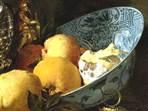 families could proudly exhibit porcelain plates, bowls, fruit dishes and butter dishes—objects associated with wealth and nobility in the rest of Europe. Between 1602 and 1650, more than 3 million pieces of Chinese porcelain were transported in huge warships by the Dutch East Indies Company to the Dutch Republic. Since little was written at that time about this Dutch obsession with China’s porcelain, we have to rely on 17th century Dutch paintings—portraits, genre scenes, and especially still lifes—to provide evidence of this mania for Asia’s riches and wonders.
families could proudly exhibit porcelain plates, bowls, fruit dishes and butter dishes—objects associated with wealth and nobility in the rest of Europe. Between 1602 and 1650, more than 3 million pieces of Chinese porcelain were transported in huge warships by the Dutch East Indies Company to the Dutch Republic. Since little was written at that time about this Dutch obsession with China’s porcelain, we have to rely on 17th century Dutch paintings—portraits, genre scenes, and especially still lifes—to provide evidence of this mania for Asia’s riches and wonders.
When remnants of East Indies Company ship, The White Lion, shipwrecked in 1613, were discovered in 1976, 290 pieces of blue and white Wanli porcelain still in pristine condition were brought to the surface. Now in the Rijksmuseum, these dishes—made before 1613, in Jingdezhen—have become reference points in the study of what is labeled Kraak porcelain, named after the type of Portuguese ship, carracks, that had first introduced this porcelain to the Dutch Republic. Kraak porcelain is recognized by 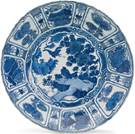 sketchy but well painted designs, with alternating wide and narrow panels filled with Daoist symbols and flowers, and by centers filled with auspicious nature scenes. The known dates of these porcelains confirm the remarkably precise depiction of the Chinese porcelains in 17th century Dutch paintings. With the new middle-class craze for these exotic blue and white dishes, Dutch potters soon created imitation Chinese ceramic-ware and called it “porcelain.”
sketchy but well painted designs, with alternating wide and narrow panels filled with Daoist symbols and flowers, and by centers filled with auspicious nature scenes. The known dates of these porcelains confirm the remarkably precise depiction of the Chinese porcelains in 17th century Dutch paintings. With the new middle-class craze for these exotic blue and white dishes, Dutch potters soon created imitation Chinese ceramic-ware and called it “porcelain.”
When China descended into chaos during the 1640’s and the export of Chinese porcelain halted, the Delft potters intensified their production to satisfy the demand. By 1660 one fourth of the population of Delft depended directly or indirectly on the ceramic industry, and the city had become Europe’s center of imitation Chinese blue and white ceramics, now called Delftware. The Daoist symbols that made no sense to the Delft potters were altered into abstracted flowers or lively scribbles; the auspicious center scenes were filled with Dutch flowers, landscapes, even Madonna’s—mostly painted with a loose, spontaneous brush stroke and always surrounded by distinctively Chinese, exotic-looking broad and narrow panels. Taking advantage of the fashion for blue and white ceramic objects in Dutch homes, the potters created cheerful blue and white wall tiles, decorating them with an endless variety of everyday subjects--children, soldiers, sail boats, flowers and landscapes.
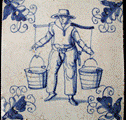
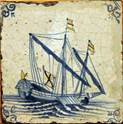
1928.36.10.4 2007.31
The Dutch mania for Chinese blue and white porcelain had led to the creation of a completely new genre: blue and white wall tiles that would become an iconic, quintessentially indigenous Dutch object, one that defines Dutch—not Chinese—identity even today. The San Diego Museum of Art has in its collection over 350 17th century Delftware wall tiles, a rare Kraak flask, and a blue and white 17th century Delftware plate.

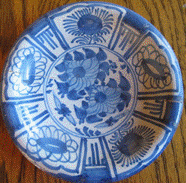
Jingdezhen Delftware Plate, 17th C.
Vase, L3959
1573-1619
1995.131
These objects can be considered visual metaphors of the radical, historic, worldwide changes due to the early 17th century global trade.

